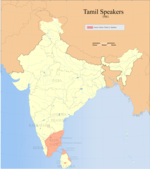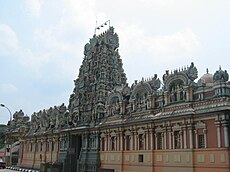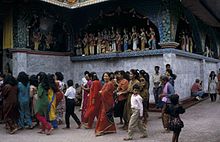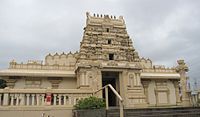Tamil diaspora
This article needs additional citations for verification. (May 2019) |
புலம்பெயர் தமிழர் | |
|---|---|
| Total population | |
| 8 million | |
| ~1,897,000 (2018.est)[1] | |
| ~600,000 (2013)[2] | |
| ~400,000[3][4] | |
| ~350,000[4][3] | |
| ~302,000[5] | |
| ~238,699[6] | |
| 237,599 (2021)[7][b] | |
| 198,449 (2020)[c][8] | |
| ~120,000 (2007)[9] | |
| ~75,000 (2008)[10] | |
| ~72,089 (2011)[11] | |
| ~60,000 (2008)[12] | |
| ~50,000 (2011)[13] | |
| ~35,000 (2008)[14] | |
| ~25,000 (2005)[15] | |
| ~10,000 (2000)[16] | |
| ~9,000 (2003)[17] | |
| Languages | |
| |
| Religion | |
| |
| Part of a series on |
| Tamils |
|---|
 |
|
Tamil portal |
The Tamil diaspora refers to descendants of the
Four groups make up the bulk of the Tamil diaspora: colonial-era descendants of migrants to Southeast Asia, South Africa, East Africa, the Caribbean, and Fiji; recent, educated Tamil immigrants primarily to the U.S., Australia, and the U.K.; Sri Lankan Tamil refugees who resettled primarily in Canada, Western and Northern Europe, and Oceania between the 1980s and 2010s; and recent Tamil migration to the Gulf states of the Middle East as labor.
Early migrations
Tamils have a long tradition of seafaring and a history of overseas migration to foreign lands due to close proximity to the Indian Ocean throughout ancient and medieval times. Many of the Tamil
]An early emigrant group that is not well documented is the
British, French, and Dutch indentured workers and others

During this period British, Dutch, French, Portuguese and Danish colony administrators recruited many local Tamils and took them to their overseas colonies to work as laborers, petty administration officers, and in clerical and military duties.
In the 19th century, the Madras Presidency (of which the Tamil Nadu region was affected by severe famines, such as the Great Famine of 1876–78. Tamil Nadu was both politically and economically weak. The British thus made use of hungry Tamil workers for their plantations all over the world - Malaysia, Singapore, Myanmar, Mauritius, South Africa, Kenya, Tanzania, Fiji and also Sri Lanka (unrelated to Tamils who migrated to Sri Lanka before the 18th century).
Some of the Tamil groups (especially the Chettiyars, Pillais, Muslims) emigrated as commercial migrants. They then dominated the trade and finance in Myanmar, Malaysia, Singapore, Sri Lanka, Mauritius, South Africa, Kenya, Tanzania and other places. The first Indian to own a merchant ship during the British times comes from this group.[20]
These Tamilians integrated and assimilated well with their adopted countries, and became well integrated into local populations in Mauritius, South Africa, Guyana, and Fiji. On the other hand,
Many also left to work in the possessions of the
Many independent Tamil merchant guilds, such as the Nagarathar, also left for these areas in an age-old tradition of their ancestors who had traded in these areas for the last 2,000 years. Britain also hired many Sri Lankan Tamils as clerical and other white-collar workers, especially in Malaysia and Singapore. All these different streams have combined to create vibrant Tamil communities in these countries.
Also, many
Twentieth century
Return migration from Sri Lanka and Burma
During and after the devastation of
There is also a movement of native Sri Lankan Tamils to India; some migrated to do white-collar jobs during the British days, but there has been a much bigger diaspora today.
Post-1983 dispersal of Sri Lankan Tamils
The
20th century dispersal of Tamils from India
In the second half of the 20th century, Tamils from India migrated as skilled professionals to various parts of India and countries like UAE, Qatar, Bahrain, Saudi Arabia, UK, USA, Singapore and so on. Some of them got citizenship of respective countries but still having strong family and cultural ties with Tamil Nadu, than those who migrated before 1950, who lost touch with their ancestral links in Tamil Nadu.
By region
Africa
Mainland Africa
There is a significant number of Tamils in Africa, especially Kenya. At least 30% of the Tamils in Africa live in Kenya, followed by Uganda. Most of these people are migrants, while some have been living there for generations.
South Africa
Tamil migration to
In South Africa the Tamil Language can be taken in many schools as a Second Additional Language, It is recognised as a level 4 subject and carries points for entrance into university.
Indian Ocean islands
Mauritius
The Tamil language is taught in approximately 100 primary schools. Tamil language and literature can be studied at university level to obtain B.A. and M.A. degrees. The Mahatma Gandhi Institute promotes the Indian languages which are present in Mauritius. Tamils are attempting to include their religion and other Hindu practices. Once Tamil priests came from Jaffna in Sri Lanka, they conducted prayers in Tamil. Later, some scholars started to facilitate the population to get access to sacred books. This helped the people to learn Tamil holy Enchantment from Thevarams and Thiruvasagam[22]
Réunion

Tamil settlement in the French department of
Seychelles
Tamil traders from
Americas
North America
Canada
Canada has a large concentration of Sri Lankan Tamils, almost 90% of the Tamil population - amounting to 120,000.[22] Tamil is taught from primary to pre-university level and 100% of them learn the language with interest. The cultural needs of the community are catered to well by round the clock radio/television channels and by numerous Tamil publications - literary and religious. Several Canadian universities contain large Tamil Student Associations (TSAs).
As per the 2021 Canadian census, Tamil Canadians number approximately 240,000 and account for roughly 0.7% of Canada's population.[7][b]
There are many more pro-active voluntary organisations keeping the Tamil culture alive. Toronto is home to the largest Tamil-speaking population outside Asia.
United States
According to the U.S. Census Bureau's 2012-2016 American Community Survey, there are 438,699 people speaking Tamil at home in the US.[6]
Caribbean
French West Indies
Tamil migration to the
Guyana
Trinidad and Tobago
Tamils have been in Trinidad and Tobago since the 1840s.[22] The first Tamils arrived in Trinidad and Tobago as indentured laborers who were brought by the British to work on the sugarcane and other agricultural estates. There was a Shiva temple called the "Madras Sivalayam" or the Caura Road temple. The Deepavali celebration by the Tamils there displayed extraordinary pluralism.
Asia
South Asia
Pakistan
A large community of Tamils exists in
South-East Asia

Burma
Indonesia
Tamils were brought to Indonesia by the Dutch in the 1860s to build up their plantations. They were used as hard labor, and as the conditions were not conducive many returned in the 1940s. About 30,000 to 40,000 remained in Northern Sumatra, and as a result, there remained a concentration of Tamils in that region.
Malaysia

Malaysia has a Tamil population of 1,800,000 making up 6.3% of the Malaysian population as of 2018 starting mainly from 1901 when it was called British Malaya.[22] Initially the migration was to work in the rubber plantations but later turned to trade and other professions mostly in the government sector such as the railways and the Public Works Department. The first Tamil school was there as early as 1876 but by 1925 it rose to 235 and by 2018 they had 530 schools. Due to intense brain drain and citizenship problems, there is an estimated 250–300,000 Tamils which are yet to be recognized by the Government of Malaysia.
Singapore
According to the 2020 census, there were 198,449 Tamil citizens and permanent residents living in Singapore, representing 3.5% of the resident population. The number of Tamils among the 1.64 million "non-resident population"—foreigners working, studying or living in Singapore without permanent residence—was not provided.[8]
Tamil Language is one of the four official languages in Singapore.[28] An estimation of about 3.2% percent of the total population in Singapore speaks Tamil at home, while about 5% is literate in Tamil language.[29] Almost all official documents printed in Singapore are translated and distributed in Tamil as well as three other national languages. In 1956, the Singapore government decided to adopt a trilingual policy. Students were taught English, a second language, as well as Malay as a third language.[30] Today the emphasis has shifted to bilingualism, where the medium of instruction is English with the mother-tongue as a second language, while the third language is optional.
Tamil is taught as a second language in all government schools from the primary to junior college levels. Tamil is an examinable subject at all major nationwide exams. There is a daily Tamil newspaper printed in Singapore, the
Other countries
Sepoy troops from Madras (now
Vietnam had a small minority of about 3,000 Tamils mostly in Saigon (nowadays Ho Chi Minh City).[22] Dandayuthapani, Subramaniam Swamy and Mariyamman temples are located near Bến Thành Market. They were called Chitty, Chà Chetty, Xã tri, Xét ty but had left the country after 1975 incident.[33]
Thailand has about 10,000 Tamils living there while there are 1,000 Tamils in Cambodia.
West Asia
The Middle East is home to thousands of migrants from Tamil Nadu and Sri Lanka, and over 75.000 migrants immigrated to the Middle East in 2012 alone.[34] However, statistics on the numbers of migrants are scarce.
Qatar
United Arab Emirates
According to the Tamil Nadu migration survey 2015, there are 400,000 emigrants in the United Arab Emirates having come from Tamil Nadu as professionals and workers in many sectors. This figure doesn't include other ethnic Tamil coming from other Indian states or other countries.[3][4][22]
Pongal and New Year are celebrated on a grand scale in Dubai and in a few other states. The first Tamil newspaper from the Middle East region was launched from Dubai on 10 December 2014. Tamil 89.4 FM radio is a Tamil radio broadcasting from Dubai, UAE.[35]
Saudi Arabia
According to the Tamil Nadu migration survey 2015, there are 350,000 emigrants having come to Saudi Arabia from Tamil Nadu as workers. This figure doesn't include other ethnic Tamil coming from other Indian states or other countries.[3][4]
Other countries
Bahrain is home for over 7000 Tamils mostly professionals and workers.[22] Kuwait is also home for a substantial number of Tamils who are recent migrants.
Europe
Northern Europe
The first Tamil immigrant to Norway, Anthony Rajendram from Gurunagar, came to Norway in 1956. The majority of the early immigrants had contacts to Rajendram, and came as immigrant worker.[36] Most had their origins in a few villages on the edge of Jaffna town such as Gurunagar, Ariyalai and Navanthurai.[37] This first group was a starting point for future immigration to Norway. Norway has about 10,000 - 13,000 Tamils most of whom are Sri Lankan refugees. The city of Bergen is the home for about 400 Tamil families and it has become the centre for Tamil gatherings. Around 7,000 Tamils also live in the capital Oslo. Sweden has a Tamil population of about 2,000 and is of recent origin.
United Kingdom
Community estimates suggest that 150,000 Tamils lived in the United Kingdom (UK) as of 2008[update],[38][39] with a 2006 Human Rights Watch report putting the number of Sri Lankan Tamils in the UK at 110,000.[40] Migration of significant numbers of Tamils to the UK started with labor migrants in the 1940s. These were joined by students moving to the UK for education in the 1970s, and by refugees fleeing the Sri Lankan Civil War in the 1980s and 1990s.[38] The majority live in North London.[39]
Western Europe
Metropolitan France
About 302,000 Tamils live in
Germany

Switzerland
Switzerland has about 40,000 Tamils the majority of whom are from Sri Lanka who went as refugees, making the biggest non-European ethnic group.[22] Although they are well entrenched in the country and integrated with the local community, yet they are actively alive to their Hindu or Christian religious and Tamil cultural links. Temples, cultural festivals, international conferences, seminars and meetings draw many of the Tamil diaspora from other European countries to the various Swiss cities, so much so that it has become the nerve centre of Tamil cultural activism.[citation needed] A large Tamil community was established in Zurich with a place known as little Jaffna.[42]
Other countries
Denmark has over 7,000 Tamils, the majority being refugees.[22] There are two well patronised Hindu temples – one for Vinayagar and another for Abhirami – and the Tamil population has got well adapted to the Danish environment. The Netherlands also has more than 20,000 Tamils, the majority of whom are, again, refugees from Sri Lanka.
Oceania
Australasia
Australia

There are officially about 72,000 Tamils in
Numerous Tamil schools and Hindu Temples have been established in all main cities to cater for the growing
The Tamil language is one of the approved subjects for the HSC examination and Tamil skill tests are conducted for children of ages five to sixteen.
New Zealand
New Zealand has about 6,800 Tamils, mostly professionals who have migrated on their own.[44]
Melanesia
Fiji
Fiji had a Tamil population of over 110,000 having been taken there to work in the plantations by the colonial masters in the 1880s.[22] Out of an Indian population of 350,000 the Tamils could number about 80,000 now.
The number who could speak is about 5,000 only and another 1,000 could write. It is only about 6,000 who declare their origins as Tamils as most of them have got well integrated with the local population. Most of them have lost their Tamil identity and are Tamils only in name. The South Indian Sanmarga Sangam is the pioneer body that forged the Tamil culture, Tamil education and the Hindu practices in the country for a long time. In 2005, it was revealed that in the 20 primary schools managed by TISI, out of the 4940 students, 1765 took Tamil classes.[45]
New Caledonia
There are about 500 New Caledonians of Indian Tamil descent. Like in Réunion, they were known as Malabars and orinignally arrived in the 19th century from other French Territories, namely Réunion. New Caledonia has several descendants of Tamils, whose parents intermarried with the local population in the last century.
See also
- Tamil Nadu diaspora
- Indian Tamils of Sri Lanka
- Sri Lankan Tamils
- Tamil nationalism
- List of Tamil businesspeople
Notes
- ^ Includes Overseas France, especially Réunion.
- ^ mother tongue, but instead as a second or third language.
- ^ This number does not include the 1.64 million "non-resident population": foreigners working, studying or living in Singapore without permanent residence. It only includes the 5.69 million citizens and permanent residents living in Singapore.
References
- ^ "Tamil Ethnologue". Ethnologue. 2010-03-26. Retrieved 2008-06-26.
Tamil Ethnologue.
- ^ "Navaneetham Pillay The most famous South African Tamil of our times". DailyMirror. 2013-08-31.
- ^ a b c d Rajan S.I., Rajan E.S. (2019) Tamil Nadu Migrants in the Gulf. In: Rajan S., Saxena P. (eds) India's Low-Skilled Migration to the Middle East. Palgrave Macmillan, Singapore. https://doi.org/10.1007/978-981-13-9224-5_11
- ^ a b c d Singapore most preferred destination of Tamil diaspora: Study, Indo-Asian News Service
- ^ ISBN 978-2-7535-2723-2.
- ^ a b Commuting Times, Median Rents and Language other than English Use in the Home on the Rise
- ^ a b Government of Canada, Statistics Canada (2022-08-17). "Census Profile, 2021 Census of Population Profile table Canada [Country]". www12.statcan.gc.ca. Retrieved 2022-09-12.
- ^ ISBN 978-981-18-1381-8.
- ^ "Britain urged to protect Tamil Diaspora". BBC. 2006-03-26. Retrieved 2008-06-26.
According to HRW, there are about 120,000 Sri Lankan Tamils in the UK.
- ^ "Census TableBuilder - Log in". Auth.censusdata.abs.gov.au. Retrieved 17 August 2018.
- ^ "Volume: II Demographic and Fertility Characteristics" (PDF). The 2011 Housing and Population Census. Statistics Mauritius. p. 68.
- ^ Baumann, Martin (2008). "Immigrant Hinduism in Germany: Tamils from Sri Lanka and Their Temples". Harvard University. Retrieved 2008-06-26.
Since the escalation of the Sinhalese-Tamil conflict in Sri Lanka during the 1980s, about 60,000 came as asylum seekers.
- ^ "2011 Census of Population and Housing". Australian Bureau of Statistics. 18 May 2011.
- Swissinfo. 2006-02-18. Retrieved 2008-06-25.
An estimated 35,000 Tamils now live in Switzerland.
- ^ "Tamil Diaspora - Italy - இத்தாலி". Tamilnation.co. Retrieved 17 August 2018.
- ^ Raman, B. (2000-07-20). "Sri Lanka: The dilemma". The Hindu. Archived from the original on 2009-01-24. Retrieved 2008-06-26.
It is estimated that there are about 10,000 Sri Lankan Tamils in Norway -- 6,000 of them Norwegian citizens, many of whom migrated to Norway in the 1960s and the 1970s to work on its fishing fleet; and 4,000 post-1983 political refugees.
- ^ Mortensen, V. Theology and the Religions: A Dialogue, p. 110
- ^ "March 1984". UNESCO. 2017-04-25. Retrieved 2021-01-06.
- ISBN 9788132118299.
- ISBN 9788132100393.
- ^ Manipur - The People, webindia123.com
- ^ a b c d e f g h i j k l m n o p q r Sivasupramaniam, V. "History of the Tamil Diaspora". International Conferences on Skanda-Murukan.
- ^ "通学距離と安全の原因と解決法 - 悩み解消には原因解明が重要". Njtamilsangam.info. Retrieved 17 August 2018.
- ^ Bay Area Tamil Manram Archived 2010-10-27 at the Wayback Machine
- ^ "Osama's shadow on Sri Lanka?". The Hindu Business Line. Retrieved August 20, 2012.
- ^ "Strangers to Their Roots and Those Around Them". The News (Pakistan). Retrieved August 20, 2012.
- ^ "Tamil Hindus in Karachi". Pakistan Hindu Post. 21 September 2010. Retrieved August 20, 2012.
- ^ "Archived copy". Archived from the original on 2002-07-13. Retrieved 2010-10-06.
{{cite web}}: CS1 maint: archived copy as title (link) - ^ "The World Factbook — Central Intelligence Agency". Cia.gov. Retrieved 17 August 2018.
- ^ Amy J, M. Singapore: A Multilingual, Multiethnic Country.
- ^ "Two new free-to-air channels launch in Singapore - Channel NewsAsia". Archived from the original on 2012-10-22. Retrieved 2011-04-17.
- ISBN 978-981-230-418-6.
- ^ "Cộng đồng "Chà Chetty" ở Sài Gòn xưa". 2017.
- ^ "Uttar Pradesh sends the largest number of Indian workers abroad, not Kerala or Punjab". 24 June 2014. Retrieved 2015-09-15.
- ^ First Tamil daily launched in UAE
- ISBN 9781317052296.
- ISBN 9781317546368.
- ^ a b Dissanayake, Samanthi (8 December 2008). "UK Tamils polarised but powerful". BBC News. Retrieved 27 December 2009.
- ^ a b Beeston, Richard (13 June 2008). "Stop Tamil Tigers raising money in UK, says President Rajapaksa". The Times. London. Retrieved 28 December 2009.
- ^ "Funding the 'Final War': LTTE Intimidation and Extortion in the Tamil Diaspora" (PDF). Human Rights Watch. 14 March 2006. Retrieved 27 December 2009.
- ^ Webmaster, Sangam. "Tamil Diaspora - Sangam.org". Sangam.org. Retrieved 17 August 2018.
- ^ "Little Jaffna". SRF. 10 November 2011.
- ^ "Tamil home". Sbs.com.au. Retrieved 17 August 2018.
- ^ "Archived copy". Archived from the original on 2013-12-13. Retrieved 2014-03-17.
{{cite web}}: CS1 maint: archived copy as title (link) - ^ "Keep your culture the challenge for South Indians in Fiji - Fiji Times Online". Archived from the original on 2016-09-16. Retrieved 2016-09-08.

